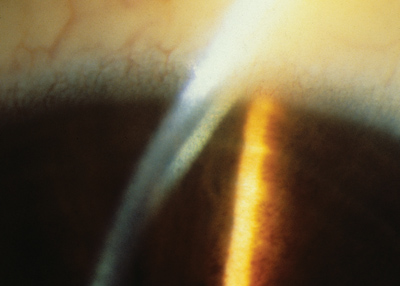
A: Wilsons disease is a genetic condition (autosomal recessive) that causes excessive copper accumulation in the liver or brain. This accumulation starts im-mediately after birth and results in hepatitis, psychiatric problems, or neurological symptoms.1 If not detected and treated, Wilsons disease can lead to copper poisoning and death.1
Patients with Wilsons disease may have jaundice; abdominal swelling; abdominal pain; vomiting of blood; tremors; and problems swallowing, talking and walking. They also may develop all types of mental illness, including depression and aggressive, homicidal or suicidal behavior.1 Women with the condition may experience irregularities in their menstrual cycle, infertility or several miscarriages.1 Symptoms of Wilsons disease usually present in late adolescence.1
One way Wilsons disease is diagnosed: via a slit-lamp exam. Patients who have Wilsons disease present with Kayser-Fleisher rings in Descemets membrane. These rings result from copper accumulation and are a rusty brown-green color, says ophthalmologist Eric D. Donnenfeld, of Lynbrook, N.Y.
If the rings are bilateral, theyre more likely to be Kayser-Fleischer rings vs. other types of corneal rings, adds ophthalmologist George Rosenwasser, of Hershey, Pa.
 |
|
A Kayser-Fleischer ring in a a patient who has Wilsons Disease. Courtesy: Antonio V. Cubillas, CRA, Bascom Palmer Eye Institute. |
A foreign body. If a foreign body is embedded in the patients cornea, a colored ring can be present, Dr. Donnenfeld says.
Keratoconus. A Fleischer ring, as seen in keratoconus patients, is yellow-brown to olive-green in color and results from the deposition of hemosiderin (iron) deep in the epithelium.2 It may or may not surround the entire base of the cone.2
Multiple myeloma. Patients who have this cancer of the plasma cellthis part of the immune system manufactures immunoglobulins to fight infection and diseasemay present with corneal rings.3 These rings do not show up as a line at the level of Descements membrane, and they have more of a granular appearance from the deposition of immunoglobulin G, Dr. Rossenwasser says.
Because you suspect Wilsons disease in this patient, refer him to his primary-care physician. Call his internist, and explain that youve identified a Kayser-Fleischer ring, which is indicative of Wilsons disease, and that as a result you believe a serum ceruloplasm test should be done, Dr. Donnenfeld says. This tests measures the amount of ceruloplasmin (a copper-containing protein) in blood serum.
Other diagnostic tests include:4
24-hour urine copper test. If the amount of copper detected in a 24-hour period is greater than 100g, the patient has Wilsons disease.
Liver biopsy. If the liver tissue extracted has a dry weight of copper that exceeds 250mg/g, the patient has Wilsons disease.
Haplotype analysis. This form of genetic testing is done on gene mutations and siblings of the suspected Wilsons disease patient.
1. Wilsons Disease Association International. About Wilsons Disease. www.wilsonsdisease.org/about%20wilsons %20disease.html. Accessed April 13, 2006.
2. Burger D, Shovlin JP, Zadnik, K. Keratoconus: diagnosis and management. Continuing Education on the Web. Pacific University College of Optometry. www.opt.pacificu.edu/ ce/catalog/web013/course.htm. Accessed April 13, 2006.
3. Multiple Myeloma Research Foundation. Intro to myeloma. www.multiplemyeloma.org/about_myeloma/index.html. Accessed April 13, 2006.
4. Sellner HA. Wilsons disease. A gastroenterology perspective. www.medhelp.org/wda/lit_gast.htm. Accessed April 13, 2006.

